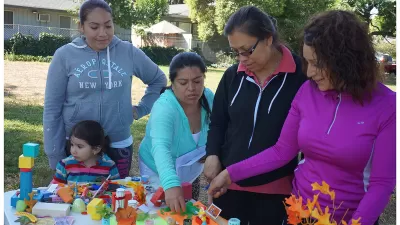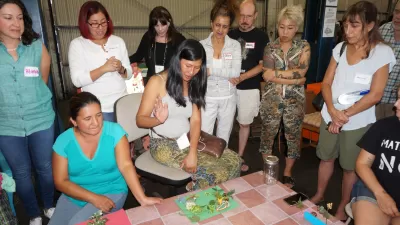A few key considerations, implemented during a public engagement process, can ensure active and engaged participation from commonly marginalized groups and individuals.

Validating people's lived experiences is critical to engaging and integrating underrepresented communities into the urban planning process. A process by which people reveal who they are, where they come from, and what they value is the first step in building key relationships.
Through Place It, I have facilitated over 400 workshops that allowed me to experiment with and develop new public engagement strategies targeting previously overlooked stakeholders, such as women, youth, immigrants, and people of color. I here present my method for integrating those perspectives into the planning process.
Because they primarily work in professional settings isolated from the communities they serve, urban planners tend to view the public as a means to an end for policy and plans—not as human beings with feelings and cultural influences. Planning meetings are usually large venues or contentious so participants have a hard time connecting with others.

Members of the public who participate in the planning process need to support in working together and in developing a shared sense of ownership over their places; this is especially important for new participants. My assumption is that anyone can be an urban planner, with something to offer to urban planning and design. If planning professionals want to access crucial community knowledge, they must start with an effective engagement strategy rooted in respect for difference.
Step 1: Creating a Safe Space
Here are the three elements central to creating a safe environment where anyone can share their lived experiences of place:
1. Setting
The setting in which the outreach activity takes place is critical. I prefer places where people routinely and organically gather, such as a mall, park, school, corner store, laundromat, etc. For my workshops, I use smaller venues that enable an intimate atmosphere where 10-30 participants can physically bond.
2. Nonverbal Communication
How we communicate is critical to building trust between city planners and participants. Cities have their own nonverbal spatial and visual languages. Residents often use that language much more intuitively than they would a planning vocabulary. Having participants build solutions with objects rather than asking them to describe their world in technical language makes it possible to communicate this experiential knowledge.
3. Validation
With a supportive setting and an accessible structure for delivering feedback, facilitators validate that no "wrong" experiences can be shared during the activity. I have found that starting from childhood memories can bring strangers from very different backgrounds together into a shared emotional space. Everybody likes talking about their own lives, especially about their favorite childhood memories. This has held true even when a participant recalls a painful moment, as is common with refugee individuals who have attended my workshops. These memories tell us who we are, where we come from, and what we value.
Building childhood memories with objects also allows participants to discover how they orient themselves toward places and people. The shared activity reveals how age, racial, economic, and professional differences shape individual perspectives on place. Through storytelling, participants document, in a non-threatening manner, how race, gender, and class can impact the aspects of place we value in our adult lives. From what I have witnessed, participants from various parts of the world and from both urban and rural settings discover that as children we were very similar.

Starting the planning process from childhood memories gives everyone an equal reference point in how they value space and people. Only later in life do economic, cultural, political, and geographical differences shape those values. The workshops allow participants to peal back their current ideas about how places should look, feel, and operate to reach a consensus bases on deep rooted values.
At the end of this activity, participants are asked to identify three words or themes that were consistent throughout everyone's memories. This reflection helps build consensus around collective values expressed within the group. Sharing these found memories with each other helps the group to bond and validates everyone experiences, which is critical for an inclusive planning process and for the next step.
Step 2: Community Planning
Now that workshop participants have a sense of what they consider important about place, they collaborate in teams to build urban planning solutions. They work for 15 minutes, choosing from the same objects they used in the individual activity.
The teams are not given a particular assignment, so all solutions are welcome. This collaboration is designed to promote the teams' sense of agency in the planning process. The communal nature of this process provides a platform that everyone can participate in regardless of typical barriers, such as language, age, ethnicity, and professional training. By building with objects in space, participants can share ideas for which they might not have words. Team members quickly test their ideas and design interventions with others. Through negotiations, new ideas emerge and become collaborative projects. In no time, the models begin to take shape. Once the time is up, each team presents their solutions, usually with conviction and enthusiasm.

In developing a variety of solutions based on their detailed understanding of the built environment, the teams reveal social and cultural patterns central to their experiences of place. Planning professionals would not normally have access to these shaping factors if they were not from the area or background. The participants tap into their individual imaginations and the community's assets to introduce inspirational ideas into the planning process.
As a wrap-up for the workshop, participants are asked to think about themes from the first and second activities. This pushes them to consider what impact the workshop will have on their perspectives on place going forward. When participants bring their life experiences into an open community-planning process, they enjoy a greater sense of empowerment about civic participation. It also gives planners important material that will enable them to serve more community needs.
Lessons Learned
The workshop creates a feeling of euphoria because people are able to stop, look, and listen to each other, and to discover something about themselves, each other, and the places they value.
Participants personalize the planning process based on their experiences, which creates a sense of ownership and attachment to each other and to place. The workshops put participants' focus on skills crucial to urban planning, such as critical thinking, creative problem-solving, collaboration, and civic literacy. In acknowledging that they already have these skills, we validate the identities of marginalized populations and increase the likelihood of these individuals and groups continuing to engage in civic activities that they otherwise would have been too intimidated, fearful, or skeptical to do. Moreover, urban planners have a social responsibility to engage with all members of community because these community members' contributions are needed in shaping the future of a more equitable American city.
PLACE IT! is a design- and participation-based urban planning practice founded by urban planner James Rojas that uses model-building workshops and on-site interactive models to help engage the public in the planning and design process.

Study: Maui’s Plan to Convert Vacation Rentals to Long-Term Housing Could Cause Nearly $1 Billion Economic Loss
The plan would reduce visitor accommodation by 25,% resulting in 1,900 jobs lost.

Placekeeping: Setting a New Precedent for City Planners
How a preservation-based approach to redevelopment and urban design can prevent displacement and honor legacy communities.

Using Old Oil and Gas Wells for Green Energy Storage
Penn State researchers have found that repurposing abandoned oil and gas wells for geothermal-assisted compressed-air energy storage can boost efficiency, reduce environmental risks, and support clean energy and job transitions.

Washington State Plans Ambitious ‘Cycle Highway’ Network
The state is directing funding to close gaps in its existing bike network and make long-distance trips more accessible.

Homeowners Blame PG&E for Delays in ADU Permits
The utility says it has dramatically reduced its backlog, but applicants say they still face months-long delays for approvals for new electrical work.

Rethinking Wildfire Defense: How a Landscape Approach Can Protect Neighborhoods
Post-fire analysis of the Eaton Fire reveals that a landscape approach — including fire-resistant vegetation, home hardening, and strategic planning — can help reduce wildfire risk, challenging assumptions that trees and plants are primary fire hazards.
Urban Design for Planners 1: Software Tools
This six-course series explores essential urban design concepts using open source software and equips planners with the tools they need to participate fully in the urban design process.
Planning for Universal Design
Learn the tools for implementing Universal Design in planning regulations.
Borough of Carlisle
Caltrans
Heyer Gruel & Associates PA
Institute for Housing and Urban Development Studies (IHS)
City of Grandview
Harvard GSD Executive Education
Salt Lake City
NYU Wagner Graduate School of Public Service
City of Cambridge, Maryland




























